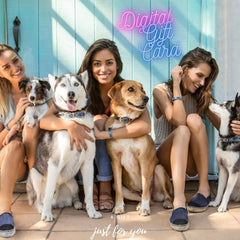Introducing a New Dog into a Multi-Pet Household
Research shows that 85 percent of dogs and 76 percent of cat owners consider their pets family members. This isn't a surprise to us because more pets bring more happiness and joy. There are, however, a few things to keep in mind if you're considering bringing a new dog into your multi-dog household. To help you get started, here are a few suggestions.
First Introductions
It's not uncommon for people to make mistakes while bringing in a new dog and introducing them to their current pets. There is an inherent sense of dominance in dogs. They may get hostile if they see a new pet in their neighborhood. Decide on a neutral location, such as a park or a neighbor's yard, for the meeting. All dogs must be accompanied by their owner and kept on a leash.
It may be necessary to walk your current dog while holding your new puppy to keep him from pulling on the leash. Taking a stroll with your new canines in a parallel fashion is a great way to get them used to being around each other in an unfamiliar setting. If you use this method often, you may be able to help the dogs find activities they like doing together and find common ground.

Remove All High-Value Resources
Keep the stakes modest by putting away any precious objects out in the open, like bones or bullies. For the first few months of your new introduction, put away your dog's favorite toy that he or she already has. Free-feeding is not recommended in a household with several pets since it is hard to control the most crucial household resource, food.
Create Safe and Separate Spaces
Allow each pet to choose whether or not to engage with the others in the household. Baby gates are a great way to create private spaces within a home. If you are introducing your new dog to a rabbit, let your bunny relax in its bed, where it feels safe after a short period of encounter with the new dog. Every now and then, allow each of them to get out for a walk alone so they may enjoy the experience and release tension.
Don't try to get them to play with each other if they're not interested. Your new puppy may be apprehensive at first, so he may prefer to take things at a slower pace. It's okay if they take their time. They'll greet each other with a wagging tail when they're ready.
Sniffing introductions should be kept to a minimum at the outset. Certain dogs may become irritated by the constant intrusion.
Keep A Positive Outlook
Reward your pet's calm, neutral behavior when they're nearby. Let's see if this works: Have each pet go to their own bed and sit or lie down on command. As an alternative to rewarding pets individually, use both hands to do so. The incentives should be small enough. Each pet should eat it quickly to avoid a shift in concentration to crumbs or pieces left on the floor.
When the dogs sniff one other, talk to them in a happy, optimistic voice. To avoid alerting dogs that something is amiss, avoid adopting a threatening tone of voice. In recognition of a job well done, it is appropriate to praise the pets.
Examine the Body Language
When it comes to dogs, we must rely solely on their body language to tell us how they feel. You should be on the lookout for signs of friendship or aggression on your first date. Friendship is demonstrated by an open, loose-lipped smile and a light-hearted curtsy, elbows on the floor, butt in the air. Rigid body posture and expressions of animosity are all symptoms of aggression. At the first sign of a fight, separate the dogs. If the dogs sit or lay down, reward them with food and praise. After the dogs have calmed down, bring them back together for a few seconds before pushing them apart again.
It Is Time for A Walk
The dogs have gotten to know one another, so it's time to have a walk together before going home. Besides getting rid of excess energy, this will help the new puppy adjust to its new environment. In addition, everyone loves a good walk.
Home Alone
The first several weeks after bringing a new pet home are very important. There must be someone at home to supervise this. If you must leave the house, place the dog in a room separated by a gate. Let other pets, such as rabbits take a break in their cute little rabbit hideout. It's important to keep time away from home as short as possible to avoid making them anxious.
Get Professional Assistance
If you feel that the dogs aren't getting along and the problem is getting out of hand, consult a professional. There is no quick fix for aggression issues; the longer you wait, the more difficult it will be to overcome them. With some outside help, your chances of having a big, happy family increase.
Begin working with a professional dog trainer as soon as possible. They can help you alter your dog's behaviors and build good, long-term habits. Maintaining a long-term equilibrium in a relationship with several pets necessitates careful management from the beginning. Latent learning is a primary mode of learning for dogs. Thus, it's crucial to ensure that your new dog doesn't pick up unwanted behaviors from the previous pets.
Training all your household together is not just a fun way to bond with the new dog, but it also gives them something to focus on except the other. Helping your pets focus and remain neutral with one another is a highly successful method of socializing.
Be Patient
The most important thing to remember is that relationships take time to form. Don't be discouraged if your dogs don't get along right away; they'll get there eventually. You and your pets will have to make some adjustments to accommodate the arrival of your new family member. Embrace the natural progression of the relationship.
Like any other change, introducing your new dog needs a high degree of consistency. It is recommended that these sessions be repeated a couple more times, each time adding additional content. It would be best to start with short sessions and increase the duration over time. Having a positive outlook and being patient will make the process much easier for you and your dogs. Graduating to off-leash play sessions and group walks should be a breeze if all goes according to plan!
It's important to introduce a new puppy to one of your current dogs at a time if you have a lot of dogs in your house. A great tip is to begin with the least enthusiastic one and work your way up to the most nervous one.
We're very happy for you and your family! It would be interesting to hear how you introduced a new dog to an already large pack of pets.
Guest Post Contributor: Melissa Kauffman
"Pet expert Melissa Kauffman has spent 25 years following her passion for animals as a writer and editor in the pet publishing industry.
Prior to starting her career in publishing, Melissa spent eight years working in veterinary hospitals where she assisted veterinarians as they treated dogs, cats, rabbits, pocket pets, reptiles, birds and one memorable lion cub."







